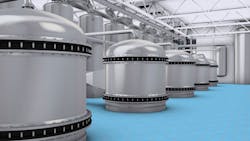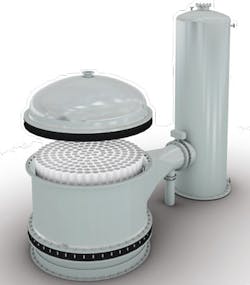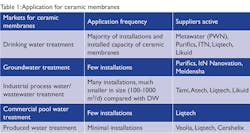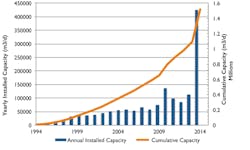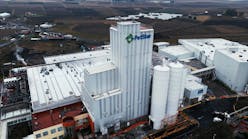Big promises have been made regarding ceramic membranes yet they still have only 2-3% of the membrane market. In a recent Insight Report on ceramic membranes, BlueTech Research, has reviewed their adoption in water and wastewater treatment, improvements in life-cycle costs, key markets and recent innovations.
By Tyler Algeo and James Fotouhi
The development of ceramic ultrafiltration (UF) membranes predates that of their polymeric counterparts. Yet ceramics only make up a fraction of the market for membrane filtration products in water and wastewater treatment. While the US$500 million UF treatment market continues to grow in applications such as reverse-osmosis pre-treatment, municipal wastewater and drinking water treatment, ceramics comprise only a 2-3% market share.
Adoption of ceramic membranes has been fairly modest, with an estimated 200+ treatment plants, representing a population equivalent of roughly five million people, over the past 20 years.
The past five years has seen a small uptick in the cumulative installed capacity, with two large-scale plants developed by PWN and Metawater (>100,000 m3/day) becoming operational in 2014.
Historically the primary barrier to ceramic membrane usage is the much higher CAPEX compared with polymerics (up to three times as much).
The process advantages of ceramic membranes (pH resistance, higher flux rates, longer membrane service life) have enabled suppliers to carve out a few niche markets such as in produced water treatment, oil/water separation, commercial pool treatment and radium removal from groundwater.
Drinking water treatment
The robustness of ceramics compared with polymerics has led to many suppliers targeting industrial and difficult-to-treat waters, however the largest market by volume of membrane sales is still drinking water treatment.
In North America and Europe UF membranes (primarily polymeric membranes) found considerable market success in drinking water treatment because the membrane is a physical barrier for microorganisms such as cryptosporidium. Outbreaks of cryptosporidium contamination in the early 90s in Nevada and Wisconsin made removal of disinfection resistant microbes a critical priority for municipalities.
Recent large-scale drinking water installations completed by PWN (Metawater/NGK) indicate that ceramics are beginning to show life-cycle cost competitiveness with polymeric membranes. A principal challenge with evaluating ceramic life-cycle cost to date was validating the service life claims of the membranes (estimated by suppliers at 15-20 years).
Commercial installations by companies such as Purifics have now been active since the early 1990s, many of which are still using the original membrane module. The validation of this claim, combined with Metawater's decreasing module CAPEX (estimated at US$100/m2) and the market's growing familiarity with the technology indicate strong potential for future growth in drinking water treatment.
A recent project tender for an upgrade to the 7 MGD (26,500 m3/day) Butte-Silver Bow Public Works Department's Basin Creek Water Treatment Plant in the US revealed that the proposed Metawater ceramic monolith system showed a better 20-year life cycle cost than the three competing UF systems proposals.
Two of the proposals were disqualified due to compliance failures in the scope, but the other accepted bid was more than US$0.9 million more than Metawater's US$8.7 million tender. Provision of a warranty for the system, a specific request of the project owners, may have contributed to Metawater's cost advantage.
Recently complete large-scale projects include the 171,000 m3/day plant in Yokahama, Japan, the 120,000 m3/day Andijk III plant in the Netherlands, and a 37,000 m3/day plant in Colorado. In late 2014, a 90,000 m3/day project was tendered in Plymouth, UK.
The added fouling resistance and ease of cleaning ceramic modules led many to speculate that produced water treatment and oil/grease removal represented a strong market opportunity for ceramics. Installations in the oil and gas industry have been few, with Veolia (CeraMem) the most active company in this area. Veolia claims to have three installations (300-400 m3/day in size) to date despite seven years of aggressively targeting the market.
Given the challenge with commercialising new water technologies in the oil and gas sector, this can be viewed as a minor success. However, given the recent decline in oil prices that are straining the targeted market segments (Canadian Oil Sands and US Shale Oil) growth potential in this area appears limited. Nevertheless, this market continues to be one targeted by ceramic membrane companies.
Early stage innovation
Young companies around the world are developing novel methods of producing ceramic membranes, even as key established producers strive to bring down the price to compete with polymeric membranes on a whole-life cost basis.
Ceramic membranes are typically produced by applying a slurry of oxide particles and solvents onto a supporting substrate and sintering the membrane in a kiln. It is a multi-step process involving successively finer layers on a substrate to produce smaller pore sizes (an important difference to polymeric membranes that can be produced "asymmetrically" in a single step).
A crop of innovative companies has appeared over the last few years offering unique and new ways to produce ceramic membranes. Some of the new methods may lead to lower production costs, while others provide enhanced performance characteristics that may swing the economics for other reasons. The following four companies are among the innovators.
Metal membranes
Metal Membranes takes a thin sheet of metal, aluminum or titanium and exposes it to a plasma arc. The plasma arc creates a highly oxidising environment at the surface of the metal plate that forms a metal-oxide layer (i.e. a porous ceramic layer -- either aluminum oxide or titanium dioxide).
The reverse of the metal plate is then etched to leave just the ceramic layer exposed. A metal plate is used as a structural support. One of the potential advantages of this manufacturing approach is that you can create very thin, layered ceramic membranes. The company indicates that it can get pore sizes in the <1nm (0.001µm) range.
Cerahelix
The Helix NFM is a ceramic nanofiltration membrane with pore sizes of approximately 1nm. The membranes are based on a (non-crystalline) titania ceramic that enables Cerahelix to narrow the pore size range. Titania is more expensive than alumina and has relatively high permeability, high hydrophilicity, a wide pH range, and is suitable for UF, nanofiltration (NF) and as a substrate.
The core of the Cerahelix technology is the method of producing the membrane layer on the substrate. A solution is produced containing DNA strands. The solution forms a gel in which the DNA strands are aligned.
This gel coats the ceramic substrate and during the sintering process the DNA is burned off, producing a ceramic membrane with a tight pore size range and straight pore channels. The straight pore channels and thinness of the active membrane layer holds the promise of better flux rates than other ceramic membranes.
Current pilot units consist of tubular or multi-channel membranes operated in cross-flow. Cerahelix has produced flat-sheet membranes as well and, for high-volume applications, will offer monoliths with more channels than its current multi-channel systems.
NanoSun
NanoSun has developed a novel flexible membrane based on titanium dioxide nanofibers with a pore size ranging from 0.1µm to 1µm (microfiltration). Lab testing has shown the membrane to have several key advantages including
- Very high flux (up to 960LMH has been demonstrated in the lab)
- Low fouling rates, high temperature tolerance (it can be heated to 250ºC to burn off organic foulants
- The ability to perform photocatalytic oxidation by exciting the titanium dioxide nanofibers with UV radiation.
The TiO2 nanofiber membrane forms a scaffold type structure and has inherent biocidal properties as well.
NanoSun's membrane is fabricated using a 3D-printing technology developed at Nanyang Technological University (NTU) with nanofibres fabricated from an electrospinning process are used as an input material. Although there are TiO2-based ceramic membranes, there are no commercial TiO2 nano-composite membranes on the market, and no other membranes are produced currently through 3D printing.
This suggests that if the membrane qualities claimed by NanoSun can be validated, the technology could be highly disruptive to the membrane market. Current testing has been done using flat-sheet plate and frame membranes; however the flexible nature of the membrane is enabling NanoSun to explore spiral-wound form factors.
Lance Energy Services
Lance Energy Services has developed a novel chemical treatment to produce "nano-functionalized ceramic membranes". The majority of testing to date has been with 0.2µm pore size (200nm) membranes.
The company indicated that the chemical treatment is not simply a coating of the membrane but results in an impregnation of the original ceramic membrane. As a result of the penetration of the chemical treatment, the modification does not wear out or disassociate from the membrane. The result of the chemical treatment is that the membrane becomes strongly hydrophilic and, as the company describes it, "organo-phobic".
According to the patent, the result is a ceramic membrane with "functionalised alumoxane nanoparticles, and zitterionic cysteic acid molecules" that make the membrane hydrophilic and prevent oil from attaching to the membrane surface.
The key advantage of the Lance Energy membrane is its anti-fouling properties with respect to oils and bacteria. The "organo-phobic" behaviour is believed to be due to the formation of an aqueous layer on the surface of the membrane that provides an entropic barrier, preventing oil droplets from contacting the surface of the membrane.
Long-term success indicated
Growing numbers of installations by major technology providers like Metawater, as well as new innovations that look to fundamentally change the production of ceramic membranes, combine with a growing market competitiveness to indicate a strong future for ceramics.
Author's note: Tyler Algeo is director of research and James Fotouhi is a water technology market analyst at BlueTech Research. For more information, email: [email protected].
More Water & WasteWater International Archives Issue Articles
